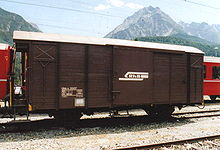
Back Крыты вагон Byelorussian Gedeckter Güterwagen German Ordinara varvagono Esperanto Vagón cerrado Spanish Kinnine vagun Estonian Wagon couvert French Gerbong tertutup ID 有蓋車 Japanese Gesloten wagen Dutch Крытый вагон Russian
A covered goods wagon or covered goods van (United Kingdom) is a railway goods wagon which is designed for the transportation of moisture-susceptible goods and therefore fully enclosed by sides and a fixed roof. They are often referred to simply as covered wagons, and this is the term used by the International Union of Railways (UIC). Since the introduction of the international classification for goods wagons by the UIC in the 1960s a distinction has been drawn between ordinary and special covered wagons. Other types of wagon, such as refrigerated vans and goods wagons with opening roofs, are closely related to covered wagons from a design point of view. Similar freight cars in North America are called boxcars.[a]


Covered goods wagons for transporting part-load or parcel goods are almost as old as the railway itself. Because part-load goods were the most common freight in the early days of the railway, the covered van was then the most important type of goods wagon and, for example, comprised about 40% of the German railways goods fleet until the 1960s.[2] Since then however the open wagon and flat wagon have become more common. By contrast the covered goods wagon still forms the majority of two-axled wagons in countries like Germany, because the comparatively light freight does not routinely require the use of bogie wagons.
The formerly widespread ordinary covered wagon with side doors was almost fully displaced in the third quarter of the 20th century by special covered wagons with sliding walls which can be rapidly loaded and unloaded with palletised goods using fork-lift trucks.
Cite error: There are <ref group=lower-alpha> tags or {{efn}} templates on this page, but the references will not show without a {{reflist|group=lower-alpha}} template or {{notelist}} template (see the help page).